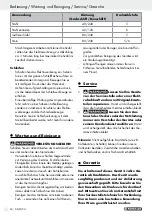
10 GB/IE
When working on wood, and especially when
working on materials which could produce
harmful dust, connect the device to a suitable
external dust extraction.
Ensure adequate ventilation when working on
plastics, paint, lacquer, etc.
The sanding brush is designed for dry grinding
areas on wood, plastic, metal and spackle, as
well as painted surfaces. Only use the device
for dry grinding.
Do not work on materials containing asbestos.
Asbestos is considered carcinogenic.
TOXIC DUST!
Dust from
materials such as lead paint, some types of
wood, minerals and metal, can be noxious.
Touching or inhaling this type of dust can pre-
sent a danger to the user or persons nearby.
Wear safety glasses and
a dust mask!
Secure the work piece. Use clamps or a vice to
secure the work piece. This is much safer than
holding it in your hand.
Never place your hands next to or in front of
the device and the surface you are working on,
as slipping poses a risk of injury.
In the event of danger, immediately pull the mains
plug out of the socket.
Always run the mains cable away from the
appliance and toward the rear.
Avoid contact with the sanding sleeve in motion.
Do not work on moistened materials or damp
surfaces.
Always apply the device to the working surface
when switched on. When the task is complete,
lift the appliance off the work piece before
switching it off.
Always firmly hold the device with both hands
whilst working. Ensure you have a solid stance.
Allow the device to come to a complete stop
and switch off before putting it down.
Always unplug from the mains socket before
taking breaks, especially working on the de-
vice (e.g. replacing sandpaper) and during
non-use.
Start-up
RISK OF INJURY!
Always
unplug from the mains before working on the sand-
ing brush.
Installing / replacing grinding
tools (see Fig. A–C)
Activate the spindle lock
5
(until it locks in)
and use the hexagonal key
10
to loosen the
clamping screw
14
.
Now remove the clamping screw.
Now remove the grinding tool.
Install the respective grinding tool accordingly,
in reverse order.
Activate the spindle lock
5
(until it locks in)
and use the hexagonal key
10
to tighten the
clamping screw
14
.
Attach the slatted grinding discs
11
directly onto
the grinding spindle
1
.
First mount the shank
13
into spindle
1
, then
insert the sanding sleeves
12
onto the shank.
Installing sanding sleeves
(see Fig. D)
Follow the direction of slats and turn the sand-
ing sleeve
12
over the mounting shank
13
until
the rubber slats are completely covered.
Removing the sanding sleeves
Be sure the mounting shank
13
remains inside
the spindle
1
during removal.
To replace or remove an old sanding sleeve
12
,
first activate the spindle lock
5
until it locks in.
Then using a rotating motion following the direc-
tion of the slats on the mounting shank
13
to pull
off the sanding sleeve
12
.
General power tool safety warnings / Start-up
Start-up / Operation











































